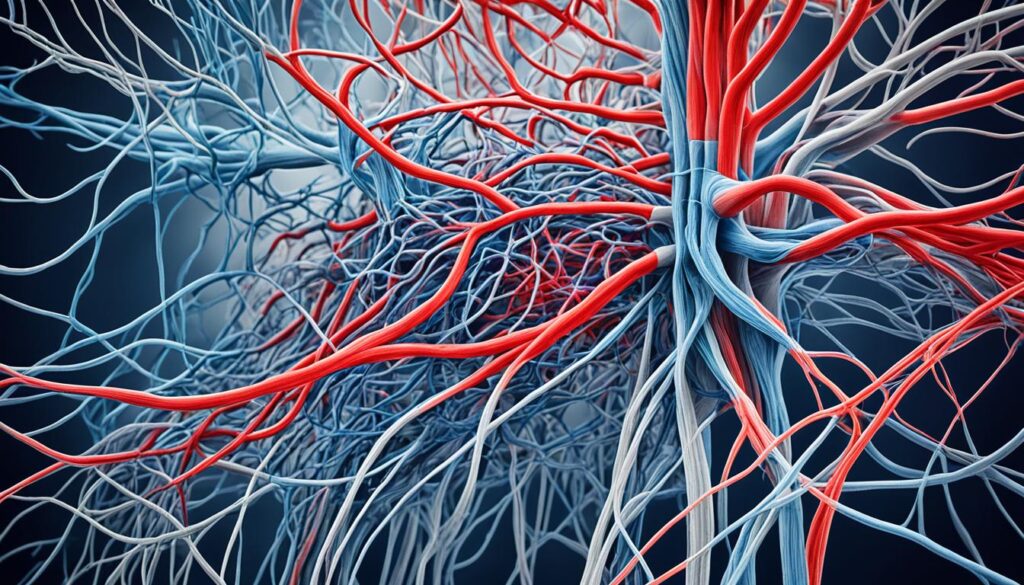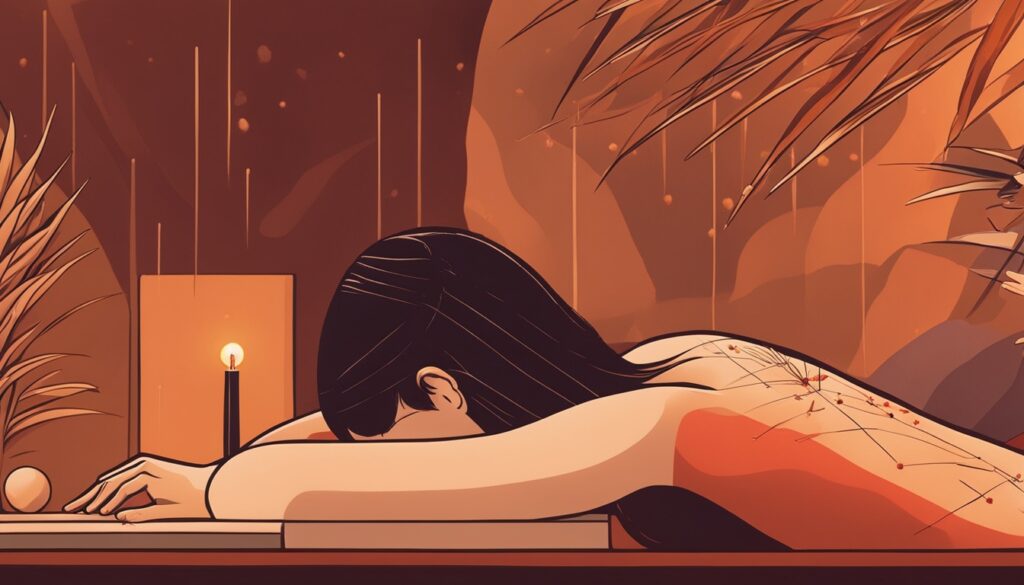Dealing with chronic pain is tough and impacts many. It becomes chronic when it lasts longer than three to six months. The cause can be from an injury or illness, affecting our nervous system.
Chronic pain is not easy to spot. It’s linked to our stress, how we feel mentally, and how active we are. To tackle it, one must use a mix of medical care, exercises, and ways to cope.
Key Takeaways:
- Chronic pain is a common, lasting issue for millions.
- It may start from an injury or illness and mess with our nervous system.
- Our stress, mental health, and how active we are can change our pain levels.
- For good pain management, using medical help, exercises, and coping skills is key.
- Working closely with health experts helps create a plan that’s just for you.
Understanding Chronic Pain Pathways
Chronic pain involves complex pathways in the body. These pathways are vital for understanding chronic pain. A process, central sensitization, increases pain signals in the nervous system. It spreads pain throughout the body, making it hard to locate.
Stress and mental health issues play a big role in chronic pain. They can amplify pain signals. This affects how we feel and react to pain.
Low activity and overworking can also lead to chronic pain. If we don’t move enough or push too hard, our bodies can hurt. This happens because of strain and swelling in our muscles.
Understanding these pathways helps doctors plan better treatments. It also lets patients choose smarter ways to deal with pain.
Our thoughts and actions are closely linked to chronic pain. Negativity, like being scared to move or avoiding activities, can make pain worse. It’s important to break these habits to feel better.
The Role of Pain Perception
How we understand pain is key in chronic pain. Our thought and feelings shape our pain. Paying attention to pain or past bad experiences can make pain stronger.
Being anxious or stressed often increase our feeling of pain. But, relaxing activities like mindfulness can lower pain. This shows that pain perception is complex.
Learning about chronic pain pathways and how pain is felt can help a lot. By addressing these root causes, people can live better and control their pain.

| Factors Influencing Chronic Pain Pathways | Impact on Chronic Pain |
|---|---|
| Stress | Amplifies pain signals |
| Mental health issues (anxiety, depression) | Affects pain perception and intensity |
| Decreased activity levels | Contributes to musculoskeletal strain and inflammation |
| Overexertion | Leads to chronic pain due to physical strain |
| Thought patterns and behaviors | Perpetuate and amplify chronic pain experiences |
Coping Strategies for Chronic Pain
Living with chronic pain can be hard, but there are ways to cope. These strategies focus on self-management. They help people get back control of their lives.
1. Breathing exercises
Deep breathing can lower stress and make you feel relaxed. This can ease chronic pain. By breathing slowly and focusing, you calm your body. This reduces how much pain you feel. Doing these exercises every day helps a lot.
2. Movement therapy
Yoga or tai chi can make you stronger and more flexible. They also reduce pain. These practices calm your mind, making you feel better. A specialist can guide you in picking the right exercises.
3. Mindfulness practices
Mindfulness means focusing on now, not judging. It can include meditation and deep breathing. These practices make you more aware of your pain. They can reduce how much the pain upsets you. They help you handle the pain, making life better.
4. Meaningful activities
Doing things you love can make you forget about the pain. Whether it’s hobbies or time with friends, pick things that make you happy. These activities turn your attention away from the pain. They make you feel better.
5. Setting realistic goals
It’s vital to set goals you can actually reach. This stops pain from getting worse. By taking small steps and caring for yourself first, you achieve more. Realistic goals keep you positive. They stop you from feeling down or hopeless.
6. Good sleep habits
Getting enough sleep is key to managing pain. A good routine and cozy sleep space help you sleep better. This means less pain. Sleep should be a top priority to cope with chronic pain.
7. Eliminating unhelpful substances
Smoking and drinking can make pain worse. Cutting down on them helps with pain management. It’s a big part of taking care of chronic pain.
8. Treating related conditions
Chronic pain often comes with depression or anxiety. Treat these conditions to handle pain better. This might involve therapy or medicine. It improves both your mental health and pain.
9. Building a support system
Having people who understand is very important. Joining support groups or talking to friends can really help. It makes coping with pain easier. It also creates a sense of belonging.

Dealing with chronic pain involves many strategies. By combining these, you can feel better. These methods allow you to take the lead in your pain management. They lead to a better quality of life.
Medications for Chronic Pain
Dealing with chronic pain often includes using medications. They are used to lessen pain and make everyday activities easier. Doctors choose the right medicines depending on what type of pain you have. These drugs can make a big difference in your life.
Types of Pain Medications
Several kinds of medicines can help with chronic pain:
- Anticonvulsants help with nerve pain. They change the way the brain’s electrical signals work, which cuts down on pain. Meds like gabapentin or pregabalin are good for conditions like neuropathy or fibromyalgia.
- Some antidepressants can also manage pain. They adjust your brain’s chemicals and can lessen pain, especially with fibromyalgia or chronic headaches.
- Muscle relaxers are for pain from tight muscles or muscle spasms. They make muscles stop tensing up so you feel better.
- NSAIDs help with pain from inflammation, like in rheumatoid arthritis. You’ve probably heard of medicines like ibuprofen or naproxen sodium.
- Opioids are strong painkillers for very severe pain. They can be addictive and have serious side effects. Doctors only use them when other options have not worked, with a lot of care.
- Sedatives, like certain sleep aids, are for pain that makes sleep hard or causes anxiety. They help you relax and sleep better.
- In places where it’s allowed, medical marijuana can also help chronic pain. Its effects differ from person to person.
All medicines have good and bad points. Before you start a new medication, talk with your doctor about its side effects and how it might react with other drugs. Your doctor will pick what’s best for your specific needs and health.
Remember, it’s key to look at other ways to manage pain, not just medicines. Using different methods together can make your pain plan stronger and more rounded.

Lifestyle Changes for Chronic Pain Management
When managing chronic pain, small lifestyle shifts can bring big relief. These include managing stress, staying active, eating well, and taking care of your health. All these steps play a crucial role in easing pain.
Stress Management
Chronic pain often comes with high stress levels, which can make pain feel worse. Learning to manage stress can help you cope and lower pain. Techniques like meditation, mindfulness, and deep breathing can calm your mind. They also lower stress, easing the constant pain.
Exercise for Chronic Pain
Getting regular exercise is key to handling chronic pain. It might seem exercise could make pain worse, but that’s not often true. Low-intensity exercises can boost your strength and reduce pain. Try walking, easy swimming, or yoga to increase flexibility and support blood flow. These activities also release endorphins, which naturally fight pain.
Diet and Nutrition
Your diet is crucial for pain management. Eating foods that fight inflammation, like fruits and veggies, can lessen pain. It’s also important to stay away from processed foods and too much caffeine. Plus, drink plenty of water to keep your body functioning well.
Sleep Quality
Good sleep is vital for managing chronic pain. Try to keep a steady sleep schedule and wind down before bed. This means avoiding caffeine and screens. Make your bedroom calm and cozy for a good night’s sleep. This rest helps your body handle pain better and heal quicker.
Avoiding Alcohol and Smoking
Alcohol and smoking are bad for chronic pain. Drinking can mix poorly with pain meds and disturb your sleep. Smoking, on the other hand, worsens inflammation and limits blood flow, making pain feel stronger. Cutting back on alcohol and quitting smoking can improve your pain and health.
Therapies for Chronic Pain
Therapy is a powerful way to handle chronic pain. It looks at the whole person, dealing with both body and mind. Many therapies are out there to ease the pain and make life better for those with ongoing pain.
Cognitive-Behavioral Therapy (CBT)

Cognitive-Behavioral Therapy (CBT) is known to change how people think and act about their pain. It works by spotting and changing bad thoughts, offering ways to deal. CBT can make pain less and boost your mental health.
Counseling and Occupational Therapy
Along with CBT, talking with a counselor and trying occupational therapy can help. Counseling lets you deal with the feelings pain brings, in a safe space. OT aims to make daily life easier, helping you find ways to do things that matter without making the pain worse.
Physical Therapy
Movements are key in managing ongoing pain. Physical therapy finds and treats the physical reasons behind your pain. It includes exercises and stretches to make you stronger, more flexible, and work better. Physical therapists target your pain spots with custom exercises to ease your pain.
Alternative Therapies
There are other ways to tackle ongoing pain too. A few that could work include:
- Acupuncture: It’s an old Chinese remedy. It puts tiny needles in special spots to help the body heal and lower pain.
- Aromatherapy: Essential oils can calm you and reduce pain by making you feel good.
- Biofeedback: It teaches you to control your body’s reactions to pain by watching what your body does and learning to adjust.
- Hypnotherapy: By focusing your mind, it could change how you see pain and reduce how much it bothers you.
Relaxation methods like massages and mental pictures can help too. They work by chilling you out and lowering stress.
Integration of Therapies
Using a mix of therapies often works best. Putting together CBT, counseling, physical therapy, and other choices can target the different parts of your pain. This gives you a broad set of tools to fight pain.
Expert Advice
“Therapies are key in battling chronic pain. By dealing with both the body and mind, we can really cut down pain and boost life quality. From talking it out with a CBT specialist to moving more with physical therapy and trying out other kinds of care, there’s a lot we can do.” – Dr. Sarah Thompson, Pain Management Specialist
Seeing a pro, like a pain doctor or specialist, is a good first step. They can help choose the best therapies for you.
Medical Treatments for Chronic Pain
For chronic pain, doctors sometimes recommend advanced medical treatments. These techniques aim to lessen pain and make life better for those with long-lasting pain.
Nerve blocks are one of these treatments. During this treatment, an anesthetic is injected near the area of pain. It aims to stop the nerves from sending pain signals. As a result, the feelings of pain can go away or reduce, giving patients relief.
Another option is epidural steroid injections. In this treatment, a doctor injects a corticosteroid into the epidural space to reduce inflammation around spinal nerves. This method can lower pain and help the body work better.
Less invasive treatments include transcutaneous electrical nerve stimulation (TENS) and biofeedback. TENS uses small electric shocks to pause the pain signals and trigger the body to release natural pain killers. Biofeedback offers insights into body functions such as heart rate and muscle tension. This helps people learn to control and lessen pain.
When thinking about these treatments, talking openly with doctors is key. They’ll explain side effects, risks, and benefits. They’ll also suggest the best options for a person’s particular pain and needs.
“Nerve blocks and epidural steroid injections are effective medical treatment options for managing chronic pain. They target the source of pain and reduce inflammation, providing relief and improving overall quality of life.” – Dr. Emily Johnson, Pain Management Specialist
It’s vital to know that medical treatments have risks. Responses to treatments differ from person to person. Finding the best approach might take time. A mix of medical care, lifestyle changes, and other therapies can improve the chance of reducing chronic pain.
Next, we’ll look at alternative treatments for chronic pain. We’ll see how they fit into a complete pain management plan.
Alternative Treatments for Chronic Pain
Many people use traditional methods to handle chronic pain. But other ways could help too. Alternative treatments can work alongside medicine. They offer a more complete way to manage pain. Here are a few that have been effective.
Acupuncture
Acupuncture is from China and uses thin needles in the body. It aims to kickstart the body’s healing power. This technique has lessened pain and made life better for those with ongoing pain.
Mindfulness Training
Mindfulness means being fully present in the now. Without judging, people learn to understand their feelings and body. It has been proven to lower how we feel pain and make dealing with pain easier.
Aromatherapy
Aromatherapy uses scented oils to relax and soothe. Oils like lavender, peppermint, and eucalyptus can lower pain. You can smell them through the air, or they can be rubbed into the skin.
Hypnotherapy
Hypnotherapy puts people into a calm, suggestible state. Here, suggestions for pain relief and change are offered. It’s effective in making pain feel less and improving life quality in people with constant pain.
Music, Art, and Pet Therapy
Listening to calming music, making art, or interacting with pets can help with pain. These activities tackle stress, improve mood, and bring better total health.
Relaxation Techniques
Massage and imagination exercises can ease chronic pain. Massage relaxes muscles and makes blood flow better. Imagining peaceful scenes helps take the focus off the pain.
Alternative Treatments for Chronic Pain
| Treatment | Description | Benefits |
|---|---|---|
| Acupuncture | Traditional Chinese practice involving the insertion of thin needles into specific points of the body. | – Stimulates the body’s natural healing processes – Reduces pain intensity – Improves overall well-being |
| Mindfulness Training | Focuses on cultivating awareness of the present moment through meditation and other techniques. | – Reduces pain perception – Improves coping strategies |
| Aromatherapy | Uses essential oils to promote relaxation and alleviate pain. | – Analgesic and anti-inflammatory properties – Promotes relaxation |
| Hypnotherapy | Guides individuals into a deep state of relaxation and makes suggestions for pain relief and positive change. | – Reduces pain intensity – Improves quality of life |
| Music, Art, and Pet Therapy | Engaging in relaxing activities like listening to music, creating art, or spending time with therapy animals. | – Reduces stress – Enhances mood – Promotes overall well-being |
| Relaxation Techniques | Techniques like massage and guided imagery to induce relaxation and divert attention from pain. | – Relaxes muscles – Improves circulation – Reduces pain |
Conclusion
Managing chronic pain needs a detailed and personal plan. You can use coping skills, change your lifestyle, and try different therapies. It’s vital to team up with medical experts to make a special pain control plan.
Even though we may not cure chronic pain, we can reduce how much it affects us. Mixing medical help, therapies, and lifestyle changes, you can take control of your pain. Don’t let chronic pain rule your life. Start taking steps today to deal with it and find some relief.
FAQ
What is chronic pain?
Chronic pain lasts for more than three to six months. It’s due to injuries or illnesses. This type of pain affects the central nervous system.
How is chronic pain managed?
Managing chronic pain involves a detailed approach. This includes medical treatments, exercise, and coping methods.
What are some coping strategies for chronic pain?
Coping with chronic pain can involve various activities. Breathing exercises, moving, being mindful, and doing things you enjoy are helpful.
What medications are used for chronic pain?
Different medicines can help with chronic pain. These include things like antidepressants, muscle relaxers, and opioids. Also, some may find relief in medical marijuana.
What lifestyle changes can help with chronic pain management?
Several lifestyle changes can aid in managing chronic pain. This includes stress reduction, regular exercise, eating well, sleeping enough, and not drinking or smoking.
What therapies are available for chronic pain?
Many therapies can be used for chronic pain. These range from cognitive-behavioral therapy and counseling to acupuncture and relaxation techniques.
What medical treatments are used for chronic pain?
For medical treatments, there are several options. These include nerve blocks, steroid injections, TENS, and biofeedback.
What alternative treatments are available for chronic pain?
Alternative treatments are also widely available. They range from acupuncture and aromatherapy to pet therapy and guided imagery.
How can chronic pain be managed effectively?
Effectively managing chronic pain involves a mix of strategies. One should consider coping methods, lifestyle adjustments, various therapies, and alternative treatments.




















